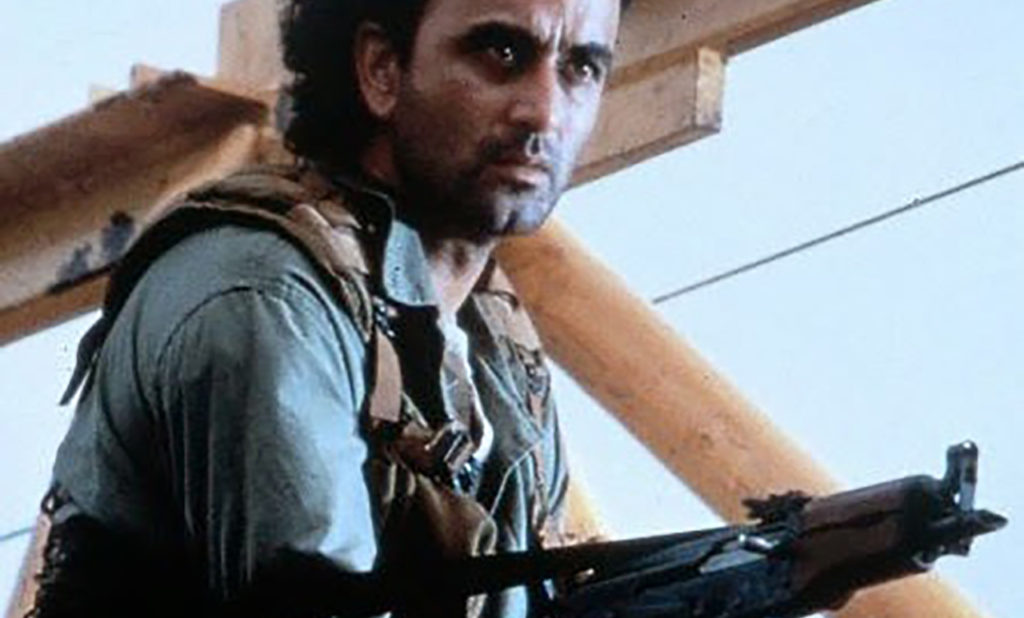It is amazing how much stays the same even after all these years. People, much of the ills of the world are caused by the ones we look at in the mirror every day.
BY JACK SHAHEEN – July 1st, 1992
Jack Shaheen (1935-2017). Photo: Al Jazeera
Portrayed as either billionaires, bombers, or belly dancers, Bedouin bandits or bundles in black—Arabs are hardly ever seen as ordinary people practicing law, driving taxis or healing the sick.
Featured since the early 1900s in more than 500 feature films and scores of television programs, Arabs still lack a human face. The typical screen Arab can be summarized in a handful of cliches: He uses terrorism and/or oil as a weapon against civilized societies. He supposedly worships a different deity than Jews and Christians, and is opposed to both religions. He treats women of his own race as chattel, but prefers to kidnap and rape white, Western women. He delights in the torture of innocents. Although often presented as a coward, at the same time he willingly dies for his cause, because, we are led to believe, he does not appreciate human life as much as “we” do.
Art Malik as Salim Abu Aziz, leader of the Crimson Jihad, in True Lies (1994).
Children with Arab roots grow up without ever having seen a human Arab on screen, someone to pattern their lives after. (When 293 secondary school teachers were asked to name any heroic or humane Arab characters they had seen in movies, 287 could think of none.) Instead, they will see animated heroes Heckle and Jeckle pull the rug from under “Ali Boo-Boo, the Desert Rat,” and Laverne and Shirley stop “Sheik Ha-Mean-ie” from conquering “the US and the world.” More than 250 comic books like The Fantastic Four and GI Combat have sketched Arab characters as “low-lifes” and “human hyenas.”
Nicholas Kadi in Navy Seals: “Someday there will be an Arab role out there for me that would be an honest portrayal.”
Nicholas Kadi, an actor with Iraqi roots, makes his living playing terrorists—the kind of Arab villains who say “America,” then spit—in such films as the 1990 release Navy Seals. Kadi admits that he does “little talking and a lot of threatening—threatening looks, threatening gestures.” The actor explains:
There are other kinds of Arabs in the world. I’d like to think that someday there will be an Arab role out there for me that would be an honest portrayal.
The ugly caricatures have had an enduring impact on Arab Americans. To many during the Gulf War, all Arabs became “camel jockeys,” “ragheads” and “sandsuckers.” Whenever there is a problem in the Middle East, Arab-Americans are subjected to vicious stereotyping and incidents of violence and discrimination. Even White House staffers—according to Reagan’s first Education Secretary, Terrel Bell—dismissed Arabs as “sand niggers.”
But trends are not uniformly bleak. On television, at least, the worst stereotyping has declined in frequency since the publication in 1984 of my book, The TV Arab, when television networks annually aired between 12–22 programs that stereotypically denigrated Arabs. A few recent shows—like Counterstrike, Shannon’s Deal and Father Dowling’s Mysteries—have actually featured sympathetic Arabs and Arab-Americans. Perhaps one day it will be possible to retire the stereotypical Arab to a media Valhalla.
Jack Shaheen was an award winning-media critic and professor of mass communications at Southern Illinois University-Edwardsville. Shaheen also authored the books The TV Arab, Reel Bad Arabs: How Hollywood Vilifies a People (made into a documentary) and Guilty: Hollywood’s Verdict on Arabs after 9/11).

